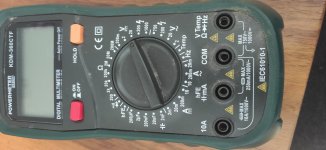Hi all, I'm searching for help repairing my old school amplifier. After some minutes listening to music the left channel start to be terribly distorted causing me a lot of pain 🤣.
My board seams to be in good condition, I cleaned and restored the varistors with contact spray and degreased with isopropyl alcohol.
This is the scheme of the board. Hope you can help me, I'm so affectionate to my old school amplifiers! 🙂
Thanks in advance!
My board seams to be in good condition, I cleaned and restored the varistors with contact spray and degreased with isopropyl alcohol.
This is the scheme of the board. Hope you can help me, I'm so affectionate to my old school amplifiers! 🙂
Thanks in advance!
Attachments
Do you have an oscilloscope?
Do you have a heat gun or blow dryer to try heating various areas/components to see which (if any) are sensitive to heat?
Is the amp's heatsink hot when it begins to distort?
Do you have a heat gun or blow dryer to try heating various areas/components to see which (if any) are sensitive to heat?
Is the amp's heatsink hot when it begins to distort?
I don't have an oscilloscope, unfortunately.. I'd like to buy one from so much time..
I've an industrial heat gun.
The heatsink became hot in the distorted channel's associated area and the power led flashes when punching basses..
I've an industrial heat gun.
The heatsink became hot in the distorted channel's associated area and the power led flashes when punching basses..
Yes, was the first try, inverted the speakers and the RCA, the speakers went distorted associated to the left amplifier's channel.
Do any components on the left channel overheat if the amp is just left to idle?
How much current does the amp draw at idle?
What's the DC voltage measured directly across the speaker terminals of each channel?
How much current does the amp draw at idle?
What's the DC voltage measured directly across the speaker terminals of each channel?
About the temperature test I have to try with the board detached from the heatsink. I'll make soon all the measurements.
Usually what is the problem that cause distortion from a single channel?
Usually what is the problem that cause distortion from a single channel?
Be very careful powering the amp up without having the FETs clamped tightly down. They can go from cold to blown in seconds.
It's going to require a lot of guesswork/questions'testing to determine the problem without a scope.
It's going to require a lot of guesswork/questions'testing to determine the problem without a scope.
It's been a VERY long time since I tried any apps like that. Since they cannot provide DC coupling, they won't be very useful.
Bear in mind that, with no protection circuit, one test of a high-voltage point could wreck the phone.
Bear in mind that, with no protection circuit, one test of a high-voltage point could wreck the phone.
In idle it measure 420mA.. the temperature stay cold for all the board components, when turn on the volume the only two became hot is the irf540 and irf9540.. but I don't know the speakers DC voltage because when I tried to measure it I smocked something.. after putting the voltmeter terminals on the speaker ends smoke comes from the two irf.. the board doesn't turn on anymore 😭
Think I fried the mtp36n06v on the left side
I've to replace that components before I can continue, even the associated resistors?
Think I fried the mtp36n06v on the left side
I've to replace that components before I can continue, even the associated resistors?
Last edited:
Did you have the meter still set to measure current?
There's no way to damage an amp by measuring the voltage across the speaker terminals with the meter set properly (including probe placement in the meter).
There's no way to damage an amp by measuring the voltage across the speaker terminals with the meter set properly (including probe placement in the meter).
With that configuration, the meter was essentially a dead short. You have to move the red probe to the voltage terminal to measure voltage.
When testing, you should use some type of current limiter. If you don't have one mentioned on the basic repair page, to protect the amp, you can use a 5 amp fuse AND have the FETs tightly clamped to the heatsink.
bcae1.com - Car Amplifier Repair Tutorial - The Basics
When testing, you should use some type of current limiter. If you don't have one mentioned on the basic repair page, to protect the amp, you can use a 5 amp fuse AND have the FETs tightly clamped to the heatsink.
bcae1.com - Car Amplifier Repair Tutorial - The Basics
I know.. was my fault but I forgot to move the probe back.. it don't leave me a second chance 😅
Your solution is a good idea I'll make it for the second try 😅
Your solution is a good idea I'll make it for the second try 😅
Yes on the transistors and R19/20.
R1 and R2 are pulldown resistors, not gate resistors (not connected to the FET gates).
R1 and R2 are pulldown resistors, not gate resistors (not connected to the FET gates).
I'm ordering all I need
Mmbt3904lt1
Mmbt3906l
101 0805 resistors
100 0805 resistors
Mpsa06
Mpsa56
Irf9450
Irf540
Irfz44pbf (instead of mtp36n06v is right?)
Lm317t
Mur1620ctg
Do you think i need to buy something else?
For the cost don't matter.. it would be worse to wait for a second order
Mmbt3904lt1
Mmbt3906l
101 0805 resistors
100 0805 resistors
Mpsa06
Mpsa56
Irf9450
Irf540
Irfz44pbf (instead of mtp36n06v is right?)
Lm317t
Mur1620ctg
Do you think i need to buy something else?
For the cost don't matter.. it would be worse to wait for a second order
- Home
- General Interest
- Car Audio
- Rockford fosgate punch 40.2 channel distortion
